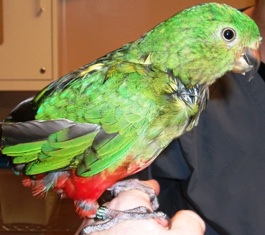Feather Loss and Circovirus Infection
Psittacine Circovirus (Psittacine Circoviral Disease or PCD) is a viral infection that is spread easily through feathers and feces. It affects parrots and other psittacine birds and causes the loss of feathers, usually on the chest or thighs. In some birds, such as Eclectus, king parrots, and lorikeets, the early signs may be a change in color, with affected feathers showing streaks of white, yellow, or black. Cockatoos and parrots often show loss of the powder down first since powder down is replaced often; it may take a few molts to see changes in coverlets and other feathers. With time, the feather loss involves the wings and the rest of the body. Early in the infection, feathers may grow in to replace the missing ones. These regrown feathers are abnormally-shaped and easily break at their bases. As the infection progresses, new feathers do not grow and old ones are not replaced. Infected birds may show excessive abnormal growth of the beak and toenails. The beak and nails curl in unusual shapes. The beak and nails may flake, crack, and develop soft areas that are weak and may break. Yeast and other infections may develop in cracks of the beak and nails. Beaks can become so severely affected that the bird can no longer feed on its own.


This infected young king parrot has yellow and black discolored feathers from PCD infection. On the right, a close-up of some infected feathers with “clubbed” tips and constricted shafts that break easily.
PCD-infected birds are more likely show other signs of illness because the virus weakens the bird’s ability to fight infections. The disease also has a general immunosuppressive effect on the bird, clearing path for secondary systemic viral and bacterial infections which are usually the cause of death, not the virus itself.
Sometimes the first sign of the disease is weakness, sleeping a lot, poor appetite, and diarrhea and vomiting. These signs are much more common in very young birds, particularly those still in the nest, rather than adult birds. Death can happen within 2 to 4 weeks of infection if the virus overwhelms the immune system of young birds. This rapid form of infection is rare. It is much more common for the initial infection to be overlooked and only detected when feather loss or changes to the beak and nails are seen. This chronic form of circoviral infection is usually noticed after the first molt as new feathers are deformed or fail to grow.
Nestlings and other young birds are more easily infected with this virus and often develop more severe signs of disease than birds infected as adults. Adult birds often may recover from the infection and not show any outward signs of the virus. Unfortunately, once infected an adult bird will shed the virus in its feathers and its feces for the rest of its life, and will pose a threat to uninfected birds.

Testing for Circovirus is an important part of the determining why a parrot is losing feathers since some birds lose feathers for other reasons. This Eclectus male has a behavior disorder known as feather-plucking.
Diagnosis relies on detecting the DNA of the virus in a bird’s feathers or feces. Once a bird is diagnosed with Circovirus, there is no “cure” that will eliminate the virus. It must be managed in ways that prevent it spreading the infection to other birds. Birds may live a few months to several years with proper care which includes a balanced diet, red palm oil, access to ultraviolet-B light or natural sunlight and proper photoperiods, regular misting or showering, and regular check-ups by a veterinarian to detect signs of other infections early. Infected birds often have yeast or bacterial infections that will respond to medical therapy, but as the bird’s immune system gets even weaker eventually the infections may not go away. At that point, your bird’s quality of life is declining. The decision to euthanize an infected bird is not always easy. It’s important to discuss quality of life with your veterinarian, and with all the members of your family, so that you recognize when your bird is suffering. However, if your infected bird is requiring ever-increasing levels of medical care or constant medications, euthanasia should be considered. If the beak or nails become severely deformed and are causing pain, euthanasia should be considered. This is not meant to discourage you but as a reminder that a Circovirus infected birds showing signs of feather loss or changes in the beak and nails rarely will live as long as an uninfected bird.



